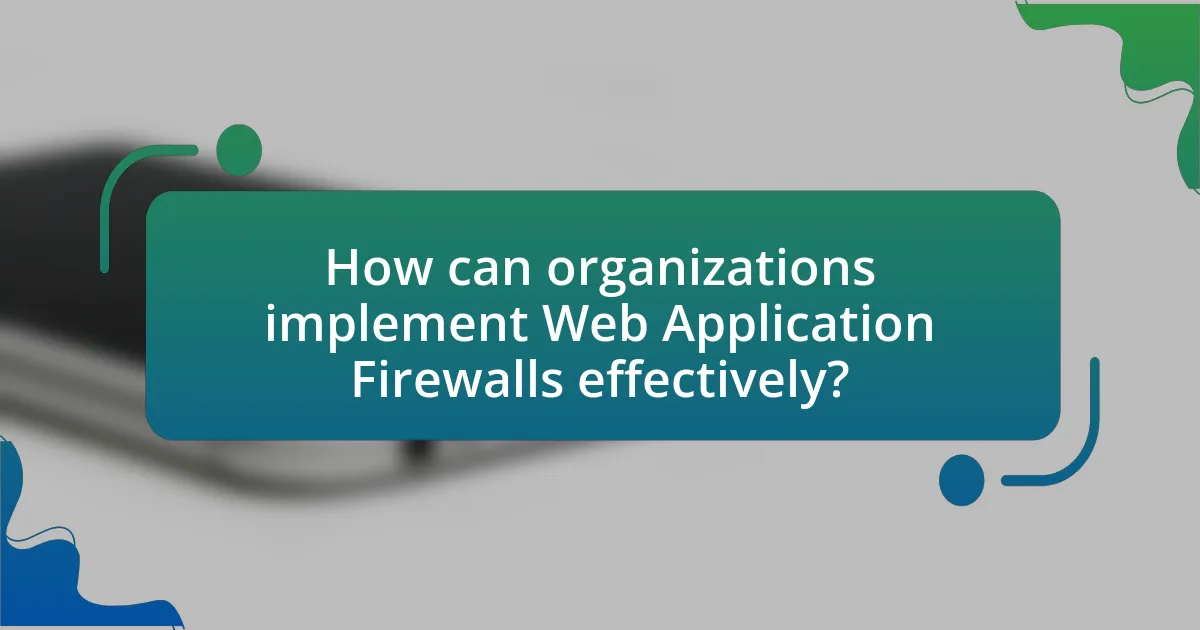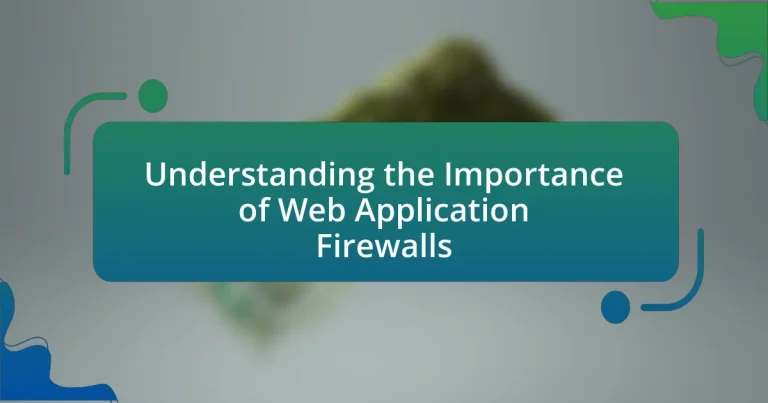A Web Application Firewall (WAF) is a critical security system that monitors and filters HTTP traffic between web applications and the internet, protecting against various cyber threats such as SQL injection and cross-site scripting. The article outlines the functionality of WAFs, including their key components like traffic filtering and rule sets, and discusses the different types of WAFs—network-based, host-based, and cloud-based. It emphasizes the importance of WAFs in enhancing overall security posture, mitigating risks associated with web vulnerabilities, and ensuring compliance with regulations. Additionally, the article provides insights into best practices for implementing and configuring WAFs effectively, as well as methods for assessing their performance and effectiveness in safeguarding sensitive data.

What is a Web Application Firewall?
A Web Application Firewall (WAF) is a security system that monitors and filters HTTP traffic between a web application and the internet. WAFs protect web applications from various attacks, such as SQL injection, cross-site scripting (XSS), and other vulnerabilities by analyzing incoming traffic and applying predefined security rules. According to the Open Web Application Security Project (OWASP), WAFs are essential for safeguarding sensitive data and ensuring compliance with regulations, as they can block malicious requests before they reach the application.
How does a Web Application Firewall function?
A Web Application Firewall (WAF) functions by monitoring, filtering, and analyzing HTTP traffic between a web application and the internet. It operates by applying a set of rules to identify and block malicious traffic, such as SQL injection, cross-site scripting (XSS), and other web-based attacks. WAFs can be deployed in various configurations, including cloud-based, on-premises, or hybrid solutions, allowing them to adapt to different security needs. According to the 2021 Verizon Data Breach Investigations Report, web application attacks accounted for 39% of all data breaches, highlighting the critical role of WAFs in protecting sensitive data and maintaining application integrity.
What are the key components of a Web Application Firewall?
The key components of a Web Application Firewall (WAF) include traffic filtering, rule sets, logging and monitoring, and protection against common web vulnerabilities. Traffic filtering allows the WAF to analyze incoming and outgoing web traffic, identifying and blocking malicious requests. Rule sets are predefined or customizable policies that dictate how the WAF responds to specific types of traffic, ensuring compliance with security standards. Logging and monitoring provide insights into traffic patterns and potential threats, enabling organizations to respond proactively to security incidents. Protection against common web vulnerabilities, such as SQL injection and cross-site scripting, is essential for safeguarding web applications from exploitation. These components collectively enhance the security posture of web applications by mitigating risks associated with cyber threats.
How do these components interact to protect web applications?
Web application firewalls (WAFs) interact with various components such as intrusion detection systems (IDS), secure coding practices, and regular security updates to protect web applications. WAFs filter and monitor HTTP traffic between a web application and the internet, blocking malicious requests based on predefined security rules. When combined with IDS, which detects and alerts on suspicious activities, WAFs enhance the overall security posture by providing real-time threat mitigation. Secure coding practices ensure that vulnerabilities are minimized during development, while regular security updates patch known exploits, further strengthening the defenses that WAFs enforce. This multi-layered approach creates a robust security framework that effectively safeguards web applications against a wide range of threats, including SQL injection and cross-site scripting attacks.
Why is a Web Application Firewall essential for web security?
A Web Application Firewall (WAF) is essential for web security because it protects web applications by filtering and monitoring HTTP traffic between a web application and the Internet. WAFs defend against common threats such as SQL injection, cross-site scripting (XSS), and other vulnerabilities that can compromise sensitive data. According to the 2021 Verizon Data Breach Investigations Report, 39% of data breaches involved web applications, highlighting the critical need for WAFs to mitigate these risks effectively. By implementing a WAF, organizations can enhance their security posture, ensuring that their web applications remain resilient against evolving cyber threats.
What types of threats does a Web Application Firewall mitigate?
A Web Application Firewall (WAF) mitigates various types of threats, including SQL injection, cross-site scripting (XSS), cross-site request forgery (CSRF), and distributed denial-of-service (DDoS) attacks. These threats target vulnerabilities in web applications, aiming to exploit data or disrupt services. For instance, SQL injection attacks manipulate database queries to gain unauthorized access to sensitive information, while XSS attacks inject malicious scripts into web pages viewed by users. According to the 2021 Verizon Data Breach Investigations Report, web application attacks accounted for 39% of all data breaches, highlighting the critical role of WAFs in protecting against these threats.
How does a Web Application Firewall enhance overall security posture?
A Web Application Firewall (WAF) enhances overall security posture by filtering and monitoring HTTP traffic between a web application and the internet. This proactive defense mechanism protects against common web vulnerabilities such as SQL injection, cross-site scripting (XSS), and other application-layer attacks. According to the 2021 Verizon Data Breach Investigations Report, 39% of data breaches involved web applications, highlighting the critical need for WAFs in mitigating these risks. By analyzing incoming requests and applying security rules, WAFs can block malicious traffic, thereby reducing the attack surface and improving the resilience of web applications against evolving threats.

What are the different types of Web Application Firewalls?
There are three main types of Web Application Firewalls (WAFs): network-based, host-based, and cloud-based. Network-based WAFs are typically hardware-based solutions that provide high performance and low latency, often deployed at the network perimeter. Host-based WAFs are software solutions installed on the web server itself, offering more customization and integration with the application but potentially consuming server resources. Cloud-based WAFs are offered as a service, providing scalability and ease of deployment without the need for physical hardware, making them suitable for businesses of all sizes. Each type serves to protect web applications from various threats, such as SQL injection and cross-site scripting, by filtering and monitoring HTTP traffic between a web application and the Internet.
How do hardware and software Web Application Firewalls differ?
Hardware Web Application Firewalls (WAFs) are physical devices that provide network-level protection, while software WAFs are applications installed on servers to protect web applications. Hardware WAFs typically offer higher performance and can handle larger volumes of traffic due to dedicated resources, making them suitable for enterprise environments. In contrast, software WAFs are more flexible and easier to deploy, allowing for customization and integration with existing systems. The choice between them often depends on specific organizational needs, such as scalability, budget, and deployment preferences.
What are the advantages and disadvantages of hardware Web Application Firewalls?
Hardware Web Application Firewalls (WAFs) offer several advantages and disadvantages. The primary advantage is their ability to provide robust security by filtering and monitoring HTTP traffic between a web application and the Internet, effectively protecting against threats like SQL injection and cross-site scripting. Additionally, hardware WAFs typically deliver high performance and low latency due to dedicated resources, making them suitable for high-traffic environments.
Conversely, the disadvantages include high initial costs and ongoing maintenance expenses, which can be significant for organizations with limited budgets. Furthermore, hardware WAFs may require specialized knowledge for configuration and management, potentially leading to operational challenges. These factors can limit their accessibility for smaller businesses or those lacking technical expertise.
What are the advantages and disadvantages of software Web Application Firewalls?
Software Web Application Firewalls (WAFs) provide several advantages and disadvantages. The primary advantage is their ability to protect web applications from various threats, such as SQL injection and cross-site scripting, by filtering and monitoring HTTP traffic. This protection is crucial, as a report by the Ponemon Institute indicates that the average cost of a data breach is $3.86 million, highlighting the financial impact of inadequate security measures.
On the downside, software WAFs can introduce latency, potentially slowing down application performance due to the additional processing of requests. Furthermore, they may require regular updates and tuning to adapt to evolving threats, which can increase operational complexity and costs. Additionally, reliance on a software WAF alone may create a false sense of security, as they cannot protect against all types of attacks, particularly those targeting the underlying infrastructure.
What role do cloud-based Web Application Firewalls play?
Cloud-based Web Application Firewalls (WAFs) protect web applications by filtering and monitoring HTTP traffic between a web application and the Internet. They play a crucial role in defending against common threats such as SQL injection, cross-site scripting (XSS), and other vulnerabilities that can compromise application security. According to a report by Gartner, organizations that implement WAFs can reduce the risk of data breaches by up to 50%, highlighting their effectiveness in safeguarding sensitive information.
How do cloud-based solutions compare to traditional Web Application Firewalls?
Cloud-based solutions offer greater scalability and flexibility compared to traditional Web Application Firewalls (WAFs). While traditional WAFs are typically hardware-based and require on-premises installation, cloud-based WAFs can be deployed quickly and adjusted to handle varying traffic loads without the need for physical infrastructure. Additionally, cloud-based solutions often provide continuous updates and threat intelligence, enhancing security against emerging threats, whereas traditional WAFs may require manual updates and maintenance. According to a report by Gartner, organizations using cloud-based WAFs can reduce operational costs by up to 30% due to lower maintenance and infrastructure expenses.
What are the benefits of using a cloud-based Web Application Firewall?
A cloud-based Web Application Firewall (WAF) provides enhanced security, scalability, and cost-effectiveness for web applications. By filtering and monitoring HTTP traffic between a web application and the Internet, a cloud-based WAF protects against various threats such as SQL injection, cross-site scripting, and DDoS attacks. According to a report by Gartner, organizations that implement a cloud-based WAF can reduce the risk of data breaches by up to 50%, demonstrating its effectiveness in safeguarding sensitive information. Additionally, cloud-based WAFs offer easy deployment and management, allowing businesses to quickly adapt to changing security needs without the overhead of maintaining physical hardware.

How can organizations implement Web Application Firewalls effectively?
Organizations can implement Web Application Firewalls (WAFs) effectively by following a structured approach that includes assessing their specific security needs, selecting the appropriate WAF solution, and continuously monitoring and updating the firewall settings. First, organizations should conduct a thorough risk assessment to identify vulnerabilities in their web applications, which informs the selection of a WAF that aligns with their security requirements. For instance, a study by the Ponemon Institute found that 60% of organizations experienced a web application attack in the past year, highlighting the need for tailored solutions.
Next, organizations must choose between cloud-based or on-premises WAF solutions based on their infrastructure and budget. Cloud-based WAFs offer scalability and ease of deployment, while on-premises solutions provide more control over security configurations. After deployment, continuous monitoring is essential; organizations should regularly review logs and alerts to detect and respond to threats promptly. According to a report by Gartner, organizations that actively monitor their WAFs can reduce the risk of data breaches by up to 30%.
Finally, organizations should regularly update their WAF rules and policies to adapt to evolving threats and ensure compliance with industry standards. This proactive approach not only enhances security but also helps maintain the integrity of web applications against emerging vulnerabilities.
What are the best practices for configuring a Web Application Firewall?
The best practices for configuring a Web Application Firewall (WAF) include defining security policies, regularly updating rules, and monitoring traffic for anomalies. Defining security policies involves specifying what types of traffic are allowed or blocked based on the application’s requirements, which helps in mitigating specific threats. Regularly updating rules is crucial as it ensures the WAF can defend against the latest vulnerabilities and attack vectors, as evidenced by the OWASP Top Ten, which highlights common web application security risks. Monitoring traffic for anomalies allows for the detection of unusual patterns that may indicate an attack, enabling timely responses to potential threats.
How can organizations tailor Web Application Firewall rules to their needs?
Organizations can tailor Web Application Firewall (WAF) rules to their needs by customizing the rule sets based on specific application requirements, threat models, and compliance mandates. This customization involves analyzing the unique traffic patterns and vulnerabilities of their web applications, allowing organizations to create rules that effectively mitigate risks while minimizing false positives. For instance, organizations can implement rules that block specific types of attacks, such as SQL injection or cross-site scripting, by leveraging threat intelligence data that identifies prevalent attack vectors relevant to their industry. Additionally, organizations can adjust the sensitivity of the WAF to balance security and user experience, ensuring legitimate traffic is not hindered. This approach is supported by industry best practices, which emphasize the importance of continuous monitoring and updating of WAF rules to adapt to evolving threats and application changes.
What common mistakes should be avoided during implementation?
Common mistakes to avoid during the implementation of web application firewalls include inadequate configuration, neglecting to update rules, and failing to monitor traffic effectively. Inadequate configuration can lead to vulnerabilities, as improperly set rules may allow malicious traffic to pass through. Neglecting to update rules can result in outdated defenses against new threats, as cyber threats evolve rapidly. Additionally, failing to monitor traffic effectively can prevent the identification of potential attacks, leaving the application exposed. These mistakes can significantly undermine the effectiveness of a web application firewall, leading to security breaches and data loss.
How can organizations assess the effectiveness of their Web Application Firewall?
Organizations can assess the effectiveness of their Web Application Firewall (WAF) by conducting regular security audits and analyzing the WAF’s performance metrics. These metrics include the number of blocked attacks, false positives, and the response time to threats. For instance, a study by the Ponemon Institute found that organizations using WAFs experienced a 50% reduction in successful web attacks, indicating the WAF’s effectiveness. Additionally, organizations can perform penetration testing to simulate attacks and evaluate how well the WAF defends against them, providing concrete evidence of its capabilities.
What metrics should be monitored to evaluate performance?
To evaluate the performance of web application firewalls (WAFs), key metrics to monitor include response time, throughput, error rates, and security event counts. Response time measures how quickly the WAF processes requests, which is crucial for user experience; studies show that a delay of just one second can reduce customer satisfaction by 16%. Throughput indicates the number of requests handled per second, reflecting the WAF’s capacity to manage traffic loads effectively. Error rates track the frequency of failed requests, helping identify potential issues in the WAF configuration or performance. Lastly, security event counts provide insights into the number of threats detected and mitigated, demonstrating the WAF’s effectiveness in protecting web applications. Monitoring these metrics ensures optimal performance and security of web applications.
How can organizations conduct regular security audits on their Web Application Firewalls?
Organizations can conduct regular security audits on their Web Application Firewalls (WAFs) by implementing a structured approach that includes reviewing configurations, analyzing logs, and performing vulnerability assessments. This process involves assessing the WAF settings to ensure they align with security policies, examining traffic logs for suspicious activities, and conducting penetration testing to identify potential weaknesses. Regular audits help organizations maintain compliance with security standards and adapt to emerging threats, as evidenced by studies showing that proactive security measures can reduce the risk of data breaches by up to 80%.
What are some common troubleshooting tips for Web Application Firewalls?
Common troubleshooting tips for Web Application Firewalls (WAFs) include checking the configuration settings, reviewing logs for blocked requests, and ensuring that the WAF is up to date with the latest security rules. Configuration settings should be verified to confirm that they align with the intended security policies, as misconfigurations can lead to false positives or negatives. Reviewing logs helps identify patterns in blocked requests, allowing for adjustments to rules that may inadvertently block legitimate traffic. Keeping the WAF updated is crucial, as security threats evolve, and updated rulesets provide better protection against new vulnerabilities.




